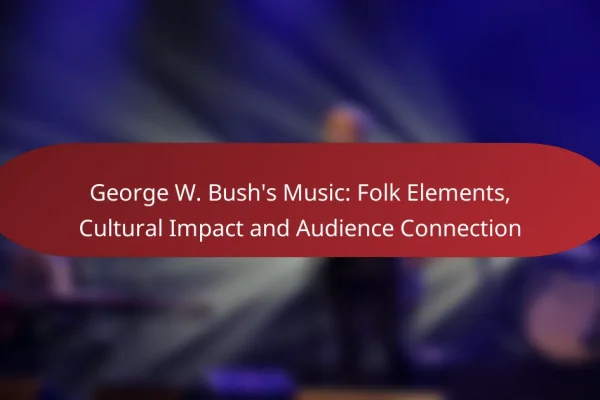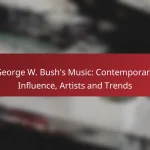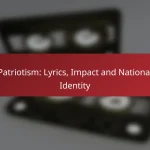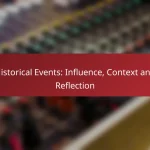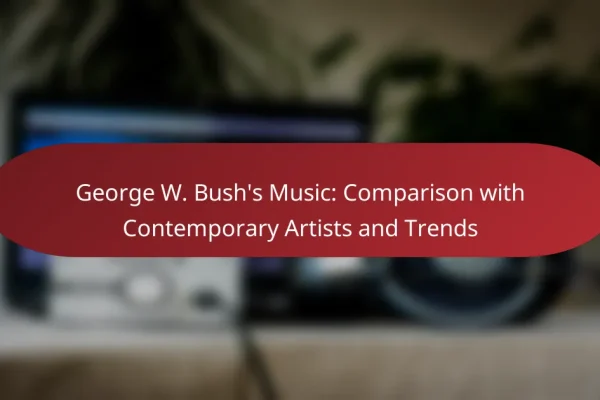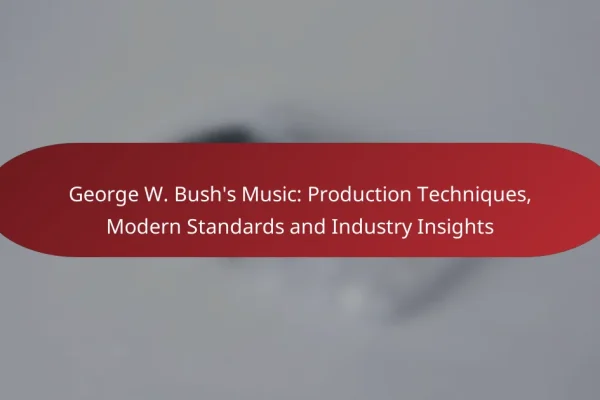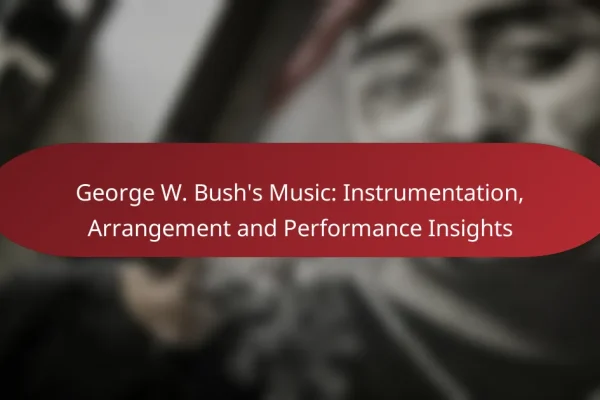What musical styles influenced George W. Bush?
George W. Bush’s musical influences are rooted in several American genres, reflecting his Texan upbringing and personal tastes. Key styles that shaped his musical preferences include country music, classic rock, blues, and Texan folk.
Country music
Country music has played a significant role in shaping George W. Bush’s musical identity. Growing up in Texas, he was exposed to artists like Willie Nelson and George Jones, whose storytelling and melodies resonate with his personal experiences and values.
Bush often expressed his appreciation for country music, attending concerts and supporting various country artists. This genre’s themes of patriotism and resilience align closely with his political persona.
Classic rock
Classic rock is another influential genre for George W. Bush, showcasing his affinity for iconic bands such as The Eagles and Lynyrd Skynyrd. The anthemic quality of classic rock songs often reflects themes of freedom and Americana, which resonate with his political messaging.
Bush’s playlists frequently included classic rock tracks, and he has been known to reference these songs in speeches, using them to connect with audiences on a cultural level.
Blues
The blues genre has also impacted George W. Bush, particularly its roots in American history and its emotional depth. Artists like B.B. King and Muddy Waters have influenced his appreciation for the genre’s storytelling and expressive qualities.
Bush’s interest in blues music highlights his recognition of the genre’s cultural significance and its connection to the broader narrative of American music history.
Texan folk
Texan folk music, with its rich traditions and regional storytelling, has been a vital part of George W. Bush’s musical landscape. This genre often features acoustic instruments and narratives that reflect the Texan experience, which resonates with his background.
Bush’s connection to Texan folk is evident in his support for local artists and his promotion of Texas culture, showcasing the importance of this genre in his overall musical influences.
How did George W. Bush’s upbringing shape his musical preferences?
George W. Bush’s upbringing in a politically influential Texas family significantly influenced his musical tastes. Growing up in an environment rich with Southern culture and local music, he developed a preference for country, rock, and blues genres that reflect his roots.
Family background in Texas
George W. Bush was born into a prominent family in Connecticut but moved to Texas at a young age. His father, George H.W. Bush, served as a U.S. President, and the family’s Texas roots exposed him to a blend of traditional Southern values and music. This background fostered an appreciation for artists like Willie Nelson and the sounds of Texas country music.
The Bush family often hosted gatherings where music played a central role, further embedding these musical influences into his life. The connection to Texas culture, with its emphasis on storytelling and emotional expression, shaped his musical preferences throughout his life.
Exposure to local music scenes
Living in Texas allowed George W. Bush to experience a vibrant local music scene. Cities like Austin, known for its live music venues, provided him with access to various genres, including country, rock, and blues. This exposure helped him appreciate the artistry and cultural significance of these musical styles.
Additionally, Bush’s interactions with musicians and participation in local events reinforced his love for music. The blend of political and musical influences in Texas created a unique backdrop that shaped his tastes and preferences, making country music a significant part of his identity.
What role did music play during George W. Bush’s presidency?
Music played a significant role during George W. Bush’s presidency, serving as a tool for communication, rallying support, and enhancing public events. It helped shape the atmosphere of his campaigns and public appearances, reflecting his personal tastes and the political climate of the time.
Campaign music choices
During his campaigns, George W. Bush utilized a variety of music to connect with voters and convey his message. Songs like “Born to Run” by Bruce Springsteen and “Eye of the Tiger” by Survivor were popular choices that resonated with themes of perseverance and hope.
Bush’s team often selected tracks that appealed to a broad audience, aiming to evoke patriotism and unity. However, some artists expressed discontent with their music being used in campaigns, leading to debates about artist consent and political messaging.
Public appearances and events
Music was a staple at George W. Bush’s public appearances, often used to energize crowds and set the tone for events. Live performances by artists at rallies and celebrations helped create a festive atmosphere, while carefully chosen playlists accompanied speeches and announcements.
Notable events, such as the inauguration ceremonies, featured musical acts that underscored the significance of the occasion. The selection of music often reflected Bush’s Texan roots, incorporating country and rock genres that resonated with his base.
How has George W. Bush expressed his musical tastes post-presidency?
Post-presidency, George W. Bush has expressed his musical tastes primarily through artistic endeavors and public performances. His engagement with music reflects his personal interests and the connections he has built over the years.
Artistic endeavors in painting
George W. Bush has taken up painting as a significant artistic outlet since leaving office. He has created a series of portraits, including those of military veterans, which showcase his appreciation for their service. His artwork often reflects themes of patriotism and personal connection, providing insight into his values and experiences.
In addition to portraits, Bush has painted landscapes and still life, demonstrating a diverse range of subjects. His paintings have been exhibited in galleries, allowing the public to engage with his artistic side and understand his perspective through visual art.
Public performances
While George W. Bush is not primarily known as a musician, he has participated in public performances that highlight his musical tastes. He has been seen playing guitar at various events, often accompanied by friends or musicians. These performances tend to be informal and reflect his enjoyment of music rather than a professional pursuit.
Bush has also expressed admiration for various music genres, including country and rock, often attending concerts and supporting artists. His participation in public performances serves as a way to connect with audiences and share his love for music in a personal manner.
What are the key themes in George W. Bush’s musical selections?
George W. Bush’s musical selections often reflect themes of patriotism and American values. His choices frequently evoke a sense of national pride and resonate with the cultural ideals of the United States.
Patriotism
Patriotism is a central theme in George W. Bush’s musical preferences, often featuring songs that celebrate the nation and its history. Tracks like “God Bless the U.S.A.” by Lee Greenwood exemplify this sentiment, highlighting the resilience and spirit of Americans.
Bush’s use of patriotic music during events and speeches reinforces a collective identity and unity among citizens. This approach not only uplifts morale but also connects audiences to shared national experiences, especially during challenging times.
American values
American values such as freedom, family, and perseverance are prominent in the music favored by George W. Bush. Songs that convey messages of hope and determination resonate with these ideals, often reflecting the American dream and the importance of community.
For example, country music, which often emphasizes storytelling and personal narratives, aligns well with Bush’s appreciation for traditional American values. This genre serves as a vehicle for expressing the struggles and triumphs of everyday Americans, reinforcing the cultural fabric of the nation.
How does George W. Bush’s musical style compare to other presidents?
George W. Bush’s musical style is characterized by a blend of country, rock, and pop influences, which sets him apart from many of his predecessors. While other presidents have embraced diverse genres, Bush’s preferences reflect his Texan roots and personal experiences, often leaning towards more mainstream and accessible music.
Musical preferences of Bill Clinton
Bill Clinton is known for his love of jazz and blues, often highlighting artists like Louis Armstrong and B.B. King. His musical tastes were shaped by his upbringing in Arkansas, where he developed a deep appreciation for the genre’s rich history and cultural significance.
Clinton frequently played the saxophone, famously performing on “The Tonight Show with Jay Leno,” which showcased his passion for music and helped popularize jazz during his presidency. His musical preferences often reflected a desire to connect with the American public through the arts.
Musical influences on Barack Obama
Barack Obama’s musical influences include a wide range of genres, particularly hip-hop, R&B, and classic rock. He often cited artists like Stevie Wonder and Jay-Z as significant influences, showcasing a modern and diverse musical palette that resonated with younger audiences.
Obama’s playlists, shared publicly, often featured a mix of contemporary and classic tracks, reflecting his belief in music’s power to inspire and unite. His administration embraced music as a cultural touchstone, hosting numerous events that celebrated various musical styles and artists.
What emerging trends in political music can be linked to George W. Bush’s era?
During George W. Bush’s presidency, political music saw a rise in protest songs and a blending of genres that reflected societal issues. Artists used their platforms to address themes such as war, patriotism, and civil liberties, shaping a new wave of politically charged music.
Protest Music Resurgence
The early 2000s marked a significant resurgence of protest music, largely in response to the Iraq War and the broader implications of U.S. foreign policy. Musicians like Green Day and Bruce Springsteen released songs that critiqued the government’s actions, resonating with a generation disillusioned by political decisions.
This trend emphasized the role of music as a form of activism, with artists using their influence to mobilize public opinion. The emotional weight of these songs often sparked discussions about national identity and morality, pushing listeners to reflect on their beliefs.
Genre Blending
Political music during Bush’s era often blended various genres, including rock, hip-hop, and folk. This fusion allowed artists to reach diverse audiences and convey complex messages through accessible sounds. For example, artists like Kanye West incorporated political themes into mainstream hip-hop, challenging listeners to engage with social issues.
This genre blending not only broadened the appeal of political music but also encouraged collaborations across different musical styles, creating a rich tapestry of sounds that highlighted urgent societal concerns.
Impact of Technology and Social Media
The rise of the internet and social media transformed how political music was distributed and consumed. Platforms like YouTube and MySpace enabled artists to share their work directly with audiences, bypassing traditional media channels. This shift allowed for quicker responses to political events and facilitated grassroots movements.
As a result, songs could go viral, amplifying their messages and mobilizing listeners in real-time. This democratization of music distribution empowered both established and emerging artists to participate in the political discourse surrounding Bush’s presidency.
